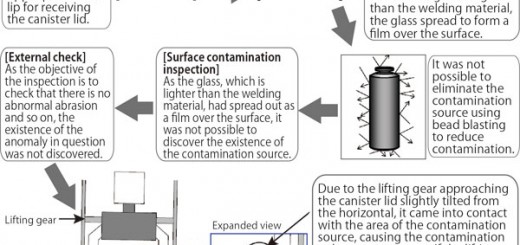Construction of Interim Spent Fuel Storage Facility Begins Nuke Info Tokyo No. 138
On August 31 the Recyclable-Fuel Storage Company (RFS), established jointly in 2005 by Tokyo Electric Power Company (TEPCO – 80%) and Japan Atomic Power Company (JAPCO – 20%), began construction work on its “Recyclable Fuel Storage Centre”, a spent fuel interim storage facility located in Mutsu City, Aomori Prefecture. The facility is scheduled to begin operations in July 2012. As electric power companies wrestle with the problem of what to do with their spent nuclear fuel, this will be the first centralized away-from-reactor interim spent fuel storage facility in Japan.
The fuel cycle program promoted by the Japanese Government has been marking time as a result of problems at the Monju Prototype Fast Breeder Reactor (see page 3) and the Rokkasho Reprocessing Plant (see page 4). Even if the Rokkasho Reprocessing Plant operates at full capacity, reprocessing 800 tons of spent fuel a year for 40 years from 2012 as planned, it is clear that of the spent fuel that will be generated at nuclear power plants during that period, Rokkasho will be unable to reprocess over half (30,000 ~ 40,000 tons).
RFS plans to accept spent nuclear fuel generated at nuclear power plants owned by TEPCO (currently 17 plants: 7 at Kashiwazaki-Kariwa, 6 at Fukushima I, 4 at Fukushima II) and JAPCO (currently 2 plants: 1 each at Tsuruga and Tokai). The same casks will be used for shipping and storage and they will be cooled using a natural cooling method.
The facility will eventually have two storage buildings with a total capacity of about 5,000 tons. The first building, which has just begun construction, will have a capacity of about 3,000 tons, or 288 casks. The period for which the spent fuel may be stored at the facility is 50 years for each building, but since the second building will not be built for another 10 to 15 years, the maximum storage period for the facility as a whole will be about 65 years.
The facility is now scheduled to begin operations before the Rokkasho Reprocessing Plant, after commercial operation of the latter was delayed by 2 years (see page 4). Therefore, even if startup of the reprocessing plant is delayed again, TEPCO and JAPCO should not have a problem storing their spent fuel. Looked at from another perspective, commencement of construction of the interim storage facility made it possible to delay the startup of the reprocessing plant by two years, and TEPCO, the biggest holder of spent nuclear fuel in Japan, for the time being does not need the Rokkasho Reprocessing Plant.
A major reason why the interim storage facility has proceeded relatively smoothly is that Mutsu City had serious financial problems and was willing to accept the facility for the sake of the various subsidies it would receive. From April 1988 to March 2009 it has received over 22 billion yen in subsidies from the central government. This money has been used for the full range of municipal activities, including salaries, roads, rivers and municipal facilities. Besides government subsidies, Mutsu City has also received donations worth 1.5 billion yen from RFS’s parent companies TEPCO and JAPCO. It was able to repair the bankrupt shopping center and turn it into a new city office. The interim storage facility was, therefore, welcomed as a “money tree” by local politicians.
Nevertheless, many residents are anxious about the facility. Yoko Nosaka, representative of the “‘We don’t need an interim nuclear storage facility’ Shimokita group”, says, “There is no guarantee that [the spent fuel] will be sent to the reprocessing plant. If we accept this facility when a final disposal site has not even been selected, Mutsu will become a nuclear waste dump.” Regarding depending on subsidies she says, “There are no signs that the city intends to stand on its own two feet. It’s like being addicted to drugs.”
Masako Sawai (CNIC)


